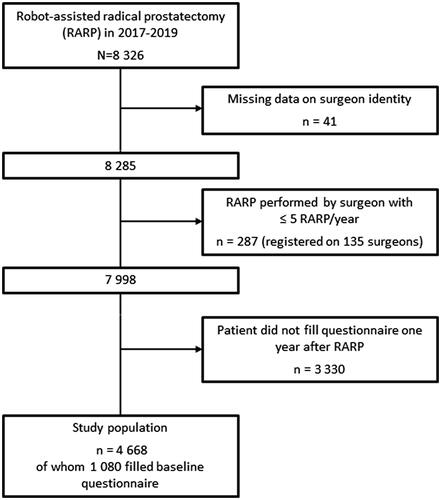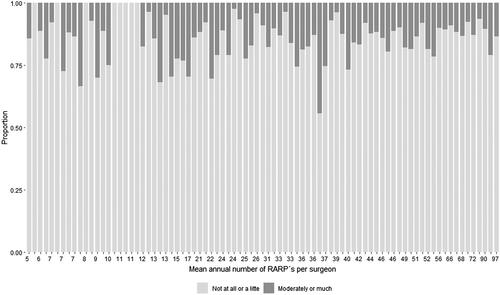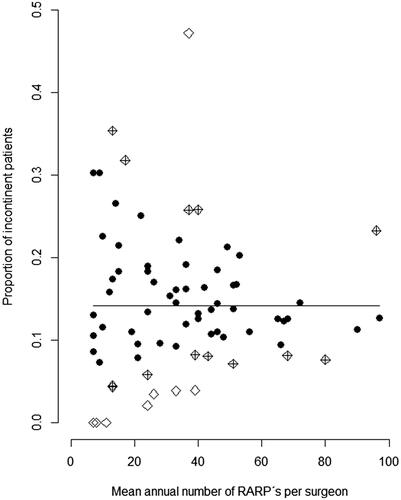Figures & data
Figure 1. Flow chart of men in The National Prostate Cancer Register of Sweden who underwent robot-assisted radical prostatectomy in 2017–2019. Number of hospitals included = 26 Number of surgeons included = 83.

Table 1. Baseline characteristics according to response/non-response to a PROM questionnaire for men in The National Prostate Cancer Register who underwent robot-assisted radical prostatectomy 2017–2019.
Figure 2. Bar plot of urinary incontinence one year after robot-assisted radical prostatectomy for individual surgeon according to the primary definition of urinary leakage. Incontinence based on the question ‘How much urine leakage do you experience?’ The alternatives ‘Not at all’, ‘A little’ defined continence and the alternatives ‘Moderately’, ‘Much/Very much’ defined incontinence. Each surgeon is represented by a bar.

Table 2. Question on urinary leakage (primary definition) in the ePROM questionnaire in The National Prostate Cancer Register.
Table 3. Risk of urinary leakage (primary definition) 1 year after robot-assisted radical prostatectomy according to PROM questionnaire.
Figure 3. Adjusted proportions of robot-assisted radical prostatectomies with incontinence one year after surgery according to surgical volume by individual surgeon. Incontinence based on the question ‘How much urine leakage do you experience?’ Alternatives ‘Not at all’, ‘A little’ defined continence and the alternatives ‘Moderately’, ‘Much/Very much’ defined incontinence. The plot is based on the results from the multivariable model that included age at RARP, CCI, PSA, prostate volume, PSA density, number of positive biopsy cores, cT stage, Gleason score, extent of lymph node dissection, nerve sparing intent, and questionnaire response rate. Surgeons with less than 10 observations were excluded in order to construct confidence intervals. The symbol indicates if the point lies inside (dot) or outside (rhombus) of the 95% confidence interval (CI) for urinary leakage. Rhombi denote surgeons with a lower/higher than expected proportion of urinary leakage, crossed rhombi 95% CI and empty rhombi 99.9% CI.

Supplemental Material
Download Zip (97.4 KB)Data availability statement
The dataset for this study was pseudonymised, the personal identity number for men in the PCBase RAPID have been deleted and replaced by a code. The code key is kept at the National Board of Health and Welfare. Due to the large number of variables, and since there is a code key, this dataset is considered not to be fully anonymised. The following restrictions therefore apply: we are not allowed to share data on individual study subjects with other researchers, nor to upload such data on an open server. However, we can provide access to the dataset on a remote server on demand where analyses can be performed and aggregated data in Figures and Tables can be exported, but no data on individual participants can be exported. Researchers apply for collaborations based on data in PCBase contact: [email protected]. After approval, a study file will be uploaded to a remote access server. Users will be charged for software licenses, administration, and data management.
